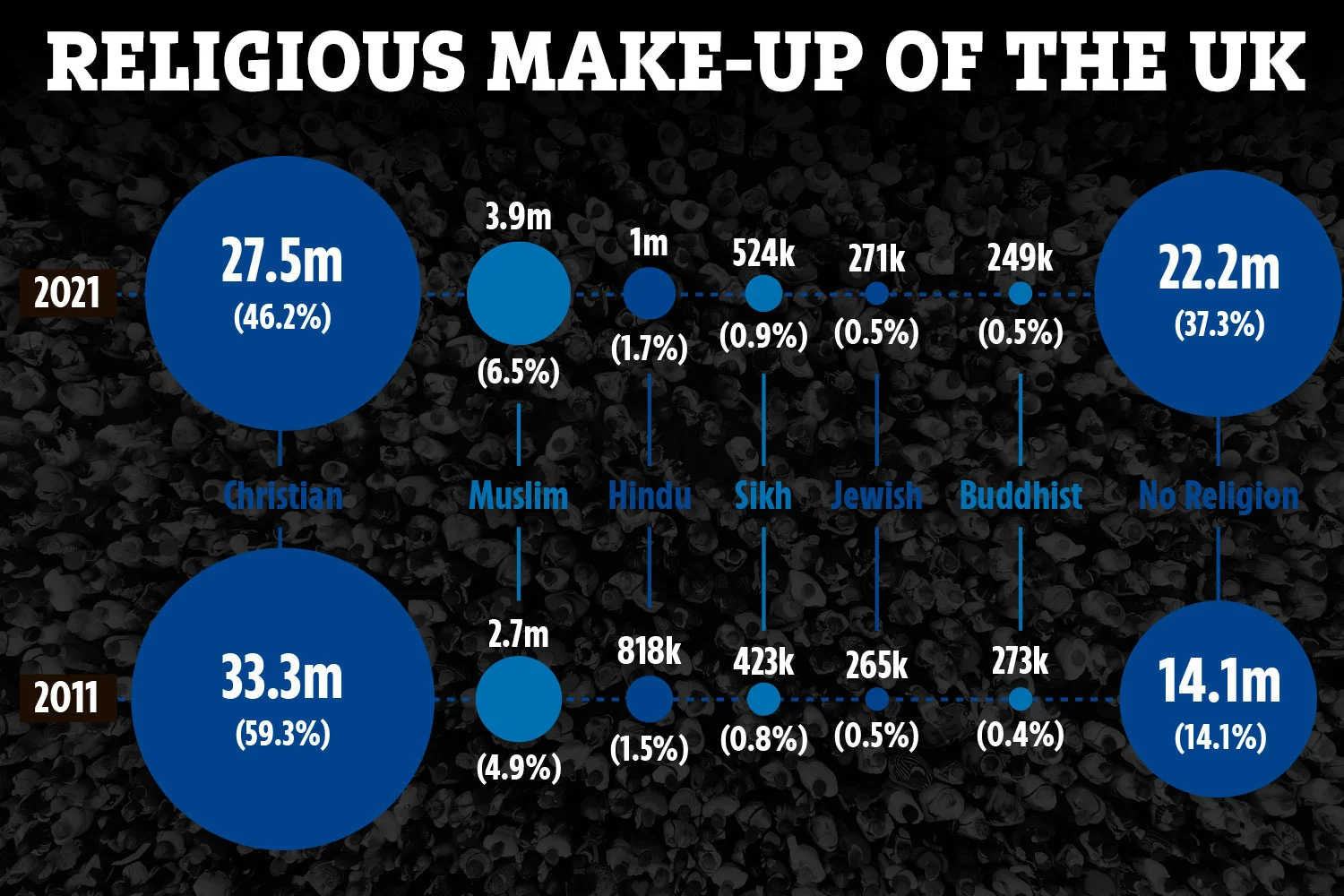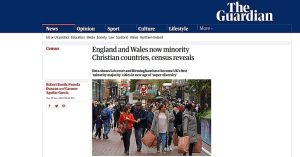Census 2021 – facts and fearmongering?

JVL Introduction
The latest information from the 2021 UK Census relates to ethnicity and religion and has provoked racist responses. Many headlines highlighted the fact that less than half the population now identifies as Christian with “no religion” being the second most common response and there has been an increase in the percentage of the population that are Muslim. The census shows that there are now two cities that no longer have a white majority population. This is factual, objective information but it seems that some in the mainstream media see this as a reason for panic rather than enabling us to, for example, better plan our services.
This piece from The Canary criticises the Guardian for its coverage and shows how important it is to present facts in a consistent manner and, I would add, allow people to make up their own minds about the facts and that demographic changes are no reason to create a moral panic!
This article was originally published by The Canary Workers' Co-op on Tue 29 Nov 2022. Read the original here.
Guardian pushes race-baiting over the Census – then changes the article
The results of the Census 2021 continue to come in. However, on Tuesday 29 November, the latest release caused gammon across the UK to collectively lose their minds – helped along by the Guardian, which then changed its article after it was published.
Census: cue moral outrage from the right wing
As Agence France-Presse (AFP) reported, for the first time, less than half of the population in England and Wales identifies as Christian. This was according to census data released Tuesday. The 10-yearly census carried out in 2021 showed ‘no religion’ was the second most common response after Christian, the Office for National Statistics (ONS) said. Data for Scotland and Northern Ireland is released separately. The ONS added the religion question to the UK census in 2001. It remains voluntary to answer, but 94% of respondents did.
Some 27.5 million people in England and Wales, or 46.2%, described themselves as Christian This was down 13.1 percentage points from 2011. ‘No religion’ rose by 12 percentage points to 37.2%, or 22.2 million, while people describing themselves as Muslim stood at 3.9 million, or 6.5% of the population, up 1.6 percentage points. The next most common responses were Hindu (one million) and Sikh (524,000), while Buddhists overtook Jewish people (273,000 to 271,000).
Of course, the real story here is that more and more people are not religious. However, not to let the facts get in the way of an opportunity, right wingers used the Census as an opportunity to drop racist horseshit – with the Guardian aiding and abetting them.
Manipulating figures
The Guardian originally wrote that:

The Guardian reports on latest census data
The census revealed a 5.5 million drop in the number of Christians and a 44% rise in the number of people following Islam.
It continued:
37.2% of people – 22.2 million – declared they had “no religion”, the second most common response after Christian. It means that over the past 20 years the proportion of people reporting no religion has soared from 14.8%.
However, the Guardian was intentionally mixing up its measurements:
It should have used either the changes in the number of people or the changes in the percentages. Instead, the Guardian used the percentage change for Muslims to make it look huge. Clearly, editors realised the pushback their biased reporting would receive – as the article was changed on the same day. It now uses the same measurements for both statistics.
However, the Guardian doubled down on the race-baiting with its dire takes on ethnicity figures.
Guardian: jumping on ethnicity
AFP reported that the ONS found the number of people in England and Wales identifying their ethnic group as white had fallen by around 500,000 since 2011. This went down from from 86% to 81.7%. The proportion identifying as white and from the British Isles stood at 74.4%, down six points from 2011. However, the ONS noted that respondents could also choose from more options than in 2011, encouraging them to list other identities.
The second most common ethnic group after white was “Asian, Asian British or Asian Welsh” at 9.3%, up from 7.5% a decade ago. Within that group, most respondents identified their family heritage as Indian, followed by Pakistani, “other Asian”, Bangladeshi, and Chinese. The next largest ethnic group was the African, followed by Caribbean.
Of course, the Guardian jumped on this. It said that places where more Black and brown people lived were called “minority majorities”:
Ushering in a new age of city-wide “super diversity”, the ONS data showed 59.1% of the people of Leicester are now from ethnic minority groups, a big change since 1991, when black and minority ethnic people made up just over a quarter of the city’s residents.
The term “super diversity” is problematic for several reasons.
Race-baiting
As professor of applied linguistics Sinfree Makoni wrote, he was:
extremely uncomfortable with the notion of diversity when used to refer to ‘mass movements’ for three main reasons. First, writing from a vantage perspective of being an immigrant in a rural university which seeks to bring to fruition diversity, I keep asking myself whether it is not the case that diversity… is a version of a description of reality that can only be advocated by those who are part of the powerful elite, such as researchers.
Second, those of us who have spent most of our professional lives outside our countries of origin find that diversity may be extremely uncomfortable, because it is typically others who do so. It is the powerful who celebrate the notion of diversity; those of us from other parts of the world feel the idea of diversity is a careful concealment of power differences…
Third, I find it disconcerting, to say the least, to have an open celebration of diversity in societies marked by violent xenophobia, such as South Africa… Furthermore, diversity stresses the differences between individuals, languages, groups, etc. Whether we are diverse or not depends on the power of the social microscope being used.
So, not only did the Guardian prop up right-wing narratives about, for example, “invasions” of refugees – it then did what the liberal media do so well, and covered its tracks by spinning it as “super diversity”. For a supposedly left-wing outlet, it does a remarkably good job of sowing the seeds of division and racism for the right wing.
Featured image via the Guardian – screengrab
Additional reporting by Agence France-Presse (AFP)

There is a problem with the graphic: the figures for Buddhists have been transposed.
Not that I care. The good news is that in the round the number of people continuing to cling to superstitious mumbo-jumbo is diminishing. “For reason in revolt now thunders” hopefully.
It’s a concern that the numbers of those adhering to non Christian faiths continue to grow, but to nowhere near the extent that people who peddle “replacement” theories would have us believe.
One further note. Observant Jews are outnumbered by faithful Muslims by more than 10 to 1 but for some reason Britain’s political parties seem particularly attuned to the demands of the former whilst virtually deaf to the latter.
I suspect that “diversity” is a form of apartheid. This is aggravated by class differences. It doesn’t have to be like that. I was once in Addis Ababa (in fact, invited by a diplomat who let me stay at the embassy), and nearby there were fancy houses mixed in with more modest ones.
‘Gammon’……whatv a nasty racist term used by Canary.